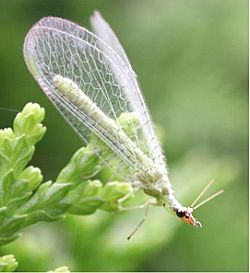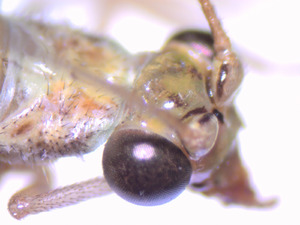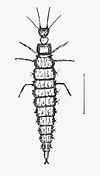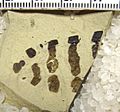Neuroptera facts for kids
Quick facts for kids NeuropteraTemporal range: Permian to Recent
|
|
|---|---|
 |
|
| Green lacewing | |
| Scientific classification | |
| Kingdom: | |
| Phylum: | |
| Class: | |
| Subclass: | |
| Infraclass: | |
| Superorder: |
Endopterygota or Neuropterida
|
| Order: |
Neuroptera
|
| Suborders | |
|
|
Neuroptera is a group of insects with net-like wings. This group includes well-known insects like lacewings, mantidflies, and antlions. There are about 6,010 different kinds, or species, of Neuroptera.
Adult Neuroptera have four see-through wings. Their front and back wings are usually about the same size. These wings have many tiny lines, called veins, that look like a net. They have chewing mouthparts, which means they can bite and chew their food. These insects go through a full change, called metamorphosis, as they grow. Most Neuroptera, both young and adult, are predators. This means they hunt and eat other insects.
The first Neuroptera appeared a very long time ago, during the Permian period.
Contents
What Are Neuropterans Like?
Neuropterans are soft-bodied insects. They do not have many very special body parts. They have large compound eyes on the sides of their heads. Some also have smaller simple eyes, called ocelli. Their mouthparts have strong mandibles, which are like jaws. These jaws are perfect for chewing. They are different from the mouthparts of many other insects in their group.
All Neuropterans have four wings. These wings are usually similar in size and shape. They have a basic pattern of veins. Some Neuropterans have special parts on their wings that help them sense things. Others have tiny hairs or other structures. These help to link their wings together when they fly.
How Do Young Neuropterans Look?
Young Neuropterans, called larvae, are special hunters. They have long mandibles that are shaped for piercing and sucking. This helps them grab and eat their prey. The shape of their body changes depending on what they eat. But generally, they have three pairs of legs on their chest area. Each leg ends with two claws. Their back part, called the abdomen, often has sticky pads. These pads are on the last two segments of their body.
Life Cycle and Habits
The larvae of most Neuropteran families are predators. Many types of green lacewings, brown lacewings, and dustywings eat aphids. Aphids are small insects that can harm plants. Because of this, some Neuropterans are used to help control pests naturally. You can find them in nature, or buy them from special companies.
Larvae in some families cover themselves with bits of dirt or even dead prey. This helps them hide from other animals. Ant lions are very good at this. They bury themselves completely out of sight. Then, they wait in "pits" in the soil to ambush their prey. Some Ithonidae larvae eat plant roots. Sisyridae larvae live in water and eat freshwater sponges. A few mantidflies are parasites of spider egg sacs. This means they live on or in spider eggs and get their food from them.
How Do Neuropterans Change?
Like other insects that go through a complete metamorphosis, Neuropterans have a pupa stage. The pupa is usually inside a cocoon. This cocoon is made of silk mixed with soil or other bits of material. When it's time, the pupa cuts its way out of the cocoon using its mandibles. It might even move around a bit before it changes into its adult form. This final change is called a moult.
Adults of many Neuropteran groups are also predators. However, some adults do not eat at all. Others only drink nectar from flowers.
Sometimes, Neuropterans are affected by parasites. These parasites can be beetles, wasps, or even some types of lake flies. They can affect Neuropterans at any stage of their life.
Neuroptera and People
People have looked into using Neuroptera to control insect pests. It can be tricky to get and keep enough Neuroptera in farm fields. But they are still helpful in nature.
Neuroptera have been shown in art for a very long time. You can find them in many art galleries. For example, there's the Lacewing Design Gallery and Studio.
People in the New Guinea Highlands say that eating Neuroptera, along with other insects, helps them stay strong. They believe it helps them keep their muscles and energy, even if they don't eat much meat.
How Neuroptera Are Related
Scientists have learned a lot more about how Neuroptera are related to each other since the 1990s. This is partly because more fossils have been found. For example, in 1995, we only knew that Megaloptera and Raphidioptera were not true Neuroptera. Now, we understand much more about the family tree of these insects.
Scientists have studied the relationships of Neuroptera using their mitochondrial DNA. While some parts are still being figured out, we know that the Myrmeleontiformia group is a true group. This means all its members come from a single common ancestor.
| Neuroptera |
|
||||||||||||||||||||||||||||||||||||
Images for kids
-
One of the "butterflies of the Jurassic", Sophogramma lii (Kalligrammatidae)
-
Patterned wing of Paleogene (49 mya) fossil Palaeopsychops marringerae (Ithonidae)
See also
 In Spanish: Neurópteros para niños
In Spanish: Neurópteros para niños














